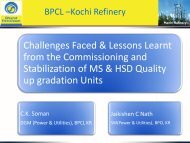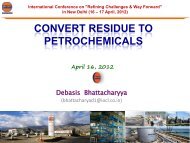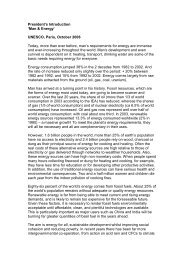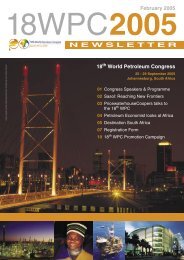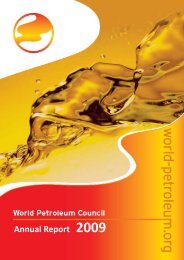pdf here - World Petroleum Council
pdf here - World Petroleum Council
pdf here - World Petroleum Council
You also want an ePaper? Increase the reach of your titles
YUMPU automatically turns print PDFs into web optimized ePapers that Google loves.
Petrochemical feedstocks<br />
Petrochemical feedstocks<br />
Petrochemical<br />
feedstocks<br />
Oil, gas and coal provide the<br />
hydrocarbons for feedstocks.<br />
Feedstocks are the various hydrocarbons derived<br />
from the refining of oil, gas and coal. These are<br />
then further refined to produce petro chemical<br />
products. They are the building blocks of<br />
petrochemical products.<br />
These building blocks are converted into a<br />
wide range of chemical products with a wide<br />
range of uses. At the feedstock stage, they are<br />
usually known as intermediates – then the intermediates<br />
are processed into plastics, liquids and<br />
resins which ultimately are turned into useful<br />
products. Some feedstocks, however, are used<br />
directly to produce petrochemicals, such as<br />
methane and BTX. But ethane, propane, butanes,<br />
naphtha and gas oil are optional feedstocks for<br />
steam crackers that produce intermediate petrochemical<br />
feedstocks. Other examples of intermediate<br />
feedstocks include ethylene, propylene,<br />
butenes and butadiene.<br />
Gas and oil are the most common starting<br />
points for feedstocks because they are still readily<br />
available, can be processed efficiently and are<br />
usually less expensive than other raw materials.<br />
This is why petrochemical companies often build<br />
their plants close to oil and gas refineries – as a<br />
result, operational costs, such as transportation,<br />
are reduced. Coal-derived feedstock, meanwhile,<br />
is mainly methanol, obtained from a coal-toliquids<br />
process. Coal can also be gasified to<br />
produce feedstocks.<br />
Methane, ethane, propane and butanes are<br />
mainly obtained from natural gas. Naphtha and<br />
gas oil, as well as benzene, toluene and xylenes, (a<br />
group commonly referred to as BTX) are obtained<br />
from petroleum refineries. Ethylene, propylene<br />
and butadiene are the basic building blocks of all<br />
olefins (also known as alkenes) and these form the<br />
basis for many common products (see diagram on<br />
page 34).<br />
Synthesis gas, also known as syngas, is the term<br />
for gas obtained from synthesising hydrogen and<br />
carbon monoxide, and this can also be converted<br />
into feedstock. Syngas can also be an intermediate<br />
by-product developed during the processing of<br />
ammonia, methanol, synthetic petroleum or<br />
synthetic natural gas. <strong>Petroleum</strong> by-products that<br />
might otherwise end up as waste can be<br />
conserved as feedstock. During the gasfication<br />
refining process, any material which contains<br />
carbon can also be converted.<br />
Since feedstocks and the end products vary,<br />
t<strong>here</strong> are many different production methods (see<br />
page 22). For example, an ethylene-producing<br />
plant is most likely to use catalytic cracking, a<br />
technique that uses high pressure and high<br />
temperatures to crack natural gas. But in a<br />
methanol-producing plant, a reforming process,<br />
using high temperature steam, medium pressure<br />
and a catalyst, will produce the product.<br />
While oil, gas and coal are still in plentiful supply<br />
in many parts of the world, alternative sour ces<br />
for petrochemical feedstocks have been developed<br />
and will continue to be developed as fossil<br />
fuels are depleted (see page 102). For example, feed -<br />
stocks can be produced from sugar cane, corn and<br />
other organic agricultural sources. While t<strong>here</strong> is<br />
controversy over using food for fuel, this is seen as<br />
a viable alternative for areas with few fossil fuel<br />
sources but space for large-scale agriculture.<br />
Feedstock and geography<br />
Feedstock supplies vary between different regions<br />
and supply trends can change, especially when new.<br />
Ethane feedstock supply has decreased in the<br />
Middle East and Canada, for example. New oil and<br />
gas discoveries have impacted on the petrochemi<br />
cal industries of the US, Brazil and Canada.<br />
In the case of the US and Brazil, both countries<br />
have benefited with the respective discoveries of<br />
shale gas and pre-salt reserves.<br />
In Canada, ethane production is down because<br />
of reduced natural gas supply from the Western<br />
Canadian Sedimentary Basin. The Canadian petrochemistry<br />
sector is now focusing on a discovery of<br />
bituminous oil, which now accounts for more<br />
than 50% of the country’s crude oil production,<br />
for meeting future feedstock needs.<br />
The petrochemical sectors of Saudi Arabia, Iran<br />
and Qatar use ethane as the main petrochemical<br />
feedstock, but securing new ethane supplies has<br />
become difficult because of high demand from<br />
existing petrochemical plants and the energy<br />
sector. As such, planned petrochemical plants in<br />
the Middle East are based on naphtha feedstock.<br />
Natural gas production increased in Saudi Arabia,<br />
Iran and Qatar but it’s not enough to satisfy the<br />
requirements. Despite the increases in nat ural gas<br />
production in Saudi Arabia and Iran, ethy lene<br />
capacity has increased even more. Qatar’s ethane<br />
production has been restricted because of a mora<br />
torium on its North Dome gas field.<br />
The emergence of China’s shale gas and coal<br />
industries has also changed the face of the world’s<br />
feedstock supplies. This ongoing development in<br />
China will serve to bolster the country’s growing<br />
economy. For more detailed information on the<br />
world’s petrochemical markets, turn to page 82.<br />
FPSO Cidade de São Paulo leaving port bound for the Sapinhoá field, offshore Brazil. Pre-salt discoveries, though challenging to extract, will<br />
have a major impact on the country’s oil and gas industries.<br />
32 WPC Guide<br />
Petrochemicals and Refining 33



